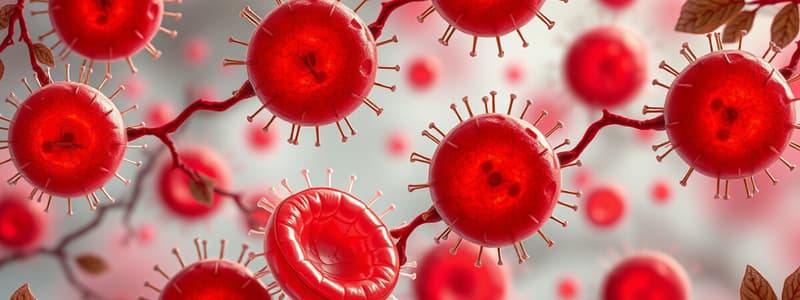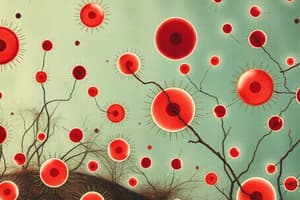Podcast
Questions and Answers
What role do growth factors play in hematopoiesis?
What role do growth factors play in hematopoiesis?
- They are only effective in the bone marrow.
- They solely stimulate stem cell proliferation.
- They inhibit the differentiation of unipotential cells.
- They can regulate multiple lineages of cells and require simultaneous action for some types. (correct)
What is a characteristic feature of precursor cells in the bone marrow?
What is a characteristic feature of precursor cells in the bone marrow?
- They only express CD34.
- They are multipotential and highly undifferentiated.
- They lack any antigen expression.
- They express additional antigens such as CD38. (correct)
Which component of the microenvironment aids in the proliferation and maturation of hematopoietic stem cells?
Which component of the microenvironment aids in the proliferation and maturation of hematopoietic stem cells?
- Adipocytes and fibroblasts.
- A combination of stromal cells and extracellular matrix. (correct)
- Only endothelial cells.
- Cytokines alone.
What process describes the formation of red blood cells?
What process describes the formation of red blood cells?
Which of the following accurately describes hematopoietic progenitor cells (HPCs)?
Which of the following accurately describes hematopoietic progenitor cells (HPCs)?
What is the significance of umbilical cord blood (UCB) in hematopoietic processes?
What is the significance of umbilical cord blood (UCB) in hematopoietic processes?
Which antigen markers are typically associated with committed progenitor cells in the hematopoietic lineage?
Which antigen markers are typically associated with committed progenitor cells in the hematopoietic lineage?
Which factor is crucial for the synchronization of the maturation of different blood cell types?
Which factor is crucial for the synchronization of the maturation of different blood cell types?
Which growth factor is primarily involved in the stimulation of erythropoiesis during the medullary period?
Which growth factor is primarily involved in the stimulation of erythropoiesis during the medullary period?
What characterizes the primitive erythroblasts formed during prenatal hematopoiesis?
What characterizes the primitive erythroblasts formed during prenatal hematopoiesis?
Which type of stem cells are known for their ability to develop into any human cell type, including cells necessary for fetal development?
Which type of stem cells are known for their ability to develop into any human cell type, including cells necessary for fetal development?
During which fetal period does granulopoiesis begin?
During which fetal period does granulopoiesis begin?
Which type of hemoglobin is produced by definitive erythroblasts?
Which type of hemoglobin is produced by definitive erythroblasts?
What is the chief site of hematopoiesis by the end of the 24th week of fetal life?
What is the chief site of hematopoiesis by the end of the 24th week of fetal life?
What stage of hematopoiesis follows the hepatic period during fetal development?
What stage of hematopoiesis follows the hepatic period during fetal development?
What is the key determining factor for the differentiation of human multipotential stem cells into specific blood cell types?
What is the key determining factor for the differentiation of human multipotential stem cells into specific blood cell types?
Which type of stem cells can only differentiate into specific types of cells to form tissues and is found in adults?
Which type of stem cells can only differentiate into specific types of cells to form tissues and is found in adults?
Which hematopoietic cytokine is primarily responsible for stimulating the production of granulocytes?
Which hematopoietic cytokine is primarily responsible for stimulating the production of granulocytes?
Erythropoiesis is influenced by which hematopoietic cytokine primarily responsible for the production of red blood cells?
Erythropoiesis is influenced by which hematopoietic cytokine primarily responsible for the production of red blood cells?
What is the significance of the mesoblastic period in prenatal hematopoiesis?
What is the significance of the mesoblastic period in prenatal hematopoiesis?
Which of the following is NOT a division of hematopoietic cells in the bone marrow?
Which of the following is NOT a division of hematopoietic cells in the bone marrow?
What part of the human body initially produces multipotent progenitor cells and hematopoietic stem cells during development?
What part of the human body initially produces multipotent progenitor cells and hematopoietic stem cells during development?
The embryonic structure from which hematopoietic stem cells first get produced is known as the?
The embryonic structure from which hematopoietic stem cells first get produced is known as the?
Which statement correctly describes the role of hematopoietic growth factors?
Which statement correctly describes the role of hematopoietic growth factors?
Study Notes
Hematopoiesis and Stem Cells
- CD34 serves as a marker for cell immaturity and is associated with hematopoietic stem and progenitor cells.
- Prefixes "BFU" (Burst Forming Unit) and "CFU" (Colony Forming Unit) indicate committed unipotential progenitor cells that differentiate along a single cell line.
Cells in the Bone Marrow (BM)
- Precursor cells exhibit additional antigens:
- CD38 – identifies precursor cells
- CD71+ – denotes erythroid cells
- CD10+ – marks B cells
- CD33+ – indicative of myeloid cells
- CD7+ and CD5+ – characterize T cells
- Blood cell formation from multipotent stem cells is regulated by growth factors and inhibitors alongside the microenvironment which governs stem cell behavior.
- The bone provides an optimal microenvironment for cell proliferation and maturation, encased by the endosteum.
Progenitor Cells
- Hematopoietic progenitor cells (HPCs) are mobilized from the BM into circulation by various stimuli, including growth factors and chemokines.
- Hematopoietic cytokines can be lineage-specific or act on multiple lineages, often requiring simultaneous action for stem cell proliferation.
- Hematopoietic stem cells (HSCs) reside in a highly organized microenvironment with stromal cells and an extracellular matrix rich in fibronectin and collagen.
- HSCs can be sourced from umbilical cord blood (UCB), which has been used for therapeutic autologous and allogeneic transplants for over 20 years.
- Cryopreservation techniques extend UCB storage viability.
Types of Human Stem Cells
- Totipotent stem cells are present shortly after fertilization and can develop into any human cell type.
- Pluripotent stem cells appear several days post-fertilization, capable of forming any cell type, but not an entire fetus.
- Multipotent stem cells, present in adults, are derived from pluripotent cells and are limited to specific tissue types (e.g., those in bone marrow).
Hematopoietic Process
- Erythropoiesis refers to the formation of red blood cells (RBCs).
- Hematopoiesis is a continuous and regulated process of blood cell production entailing cell renewal, proliferation, differentiation, and maturation within blood-forming organs.
Divisions of Hematopoietic Cells in the Bone Marrow
- Primitive multipotential cells are stem cells capable of self-renewal and differentiation into all blood cell types.
- Intermediate progenitor cells are committed and identified by CFU/BFU prefixes.
- Mature precursor cells have functional capabilities already established.
Stages of Hematopoiesis
- Prenatal hematopoiesis occurs across three periods:
- Mesoblastic Period: Begins on day 14 and peaks at one month, primarily in yolk sac blood islands, producing primitive erythroblasts containing embryonic hemoglobin.
- Hepatic Period: Starts at weeks 5-7, focusing on the liver, spleen, and lymph nodes, where definitive erythroblasts are formed, extruding their nuclei and starting granulopoiesis and megakaryopoiesis by the third month.
- Medullary/Myeloid Period: Begins in the fifth month, transitioning primary hematopoiesis to the bone marrow by six months, with measurable levels of Erythropoietin (EPO) and various colony-stimulating factors.
Post-Natal Hematopoiesis
- Ongoing process through adulthood, leveraging the established hematopoietic system developed during prenatal stages.
Studying That Suits You
Use AI to generate personalized quizzes and flashcards to suit your learning preferences.
Related Documents
Description
This quiz focuses on the markers and stages of blood cell development in the bone marrow. It covers the role of CD34 in identifying precursor cells and the differentiation of various lineages. Test your knowledge on hematopoiesis and the significance of different cell surface antigens.




